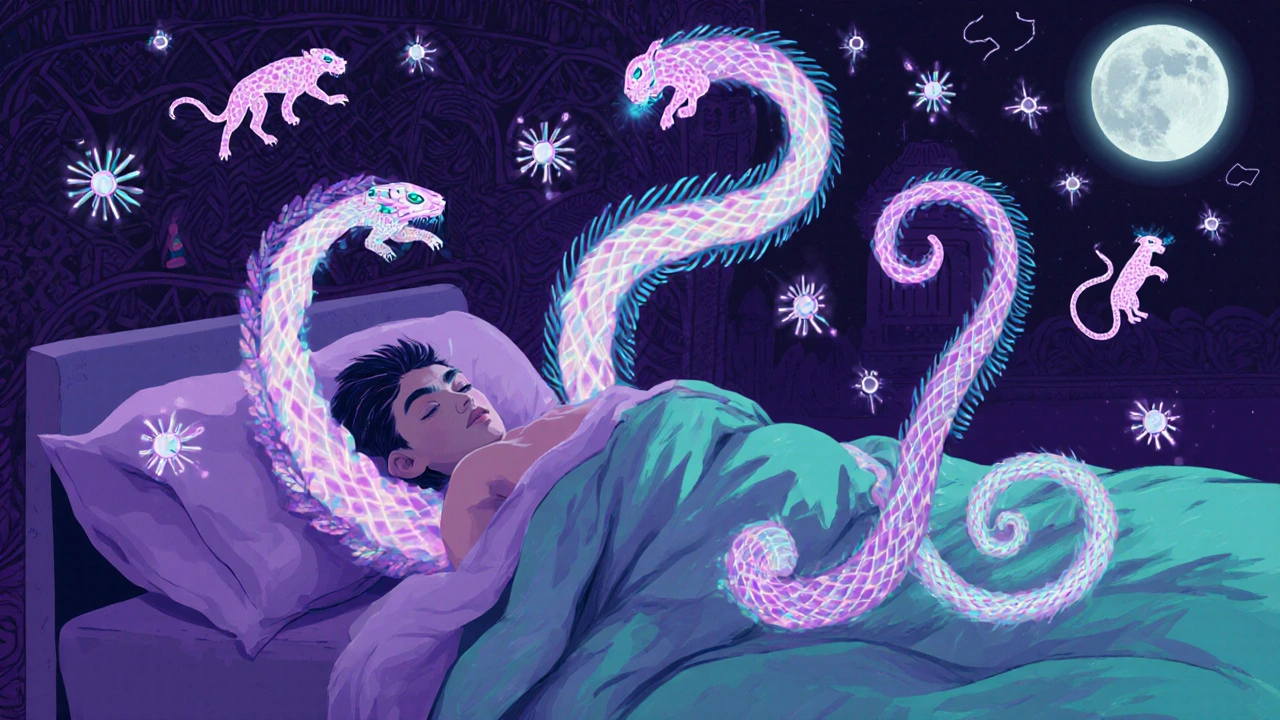Every night, as you lie down to sleep, your legs start to crawl. Not with bugs - but with an ache, a tingle, a pull so strong you have to get up and walk. Not because you’re anxious. Not because you’re restless. But because your body is screaming for movement. This isn’t just discomfort. This is restless legs syndrome - a neurological condition that steals sleep, drains energy, and turns nights into battles.
Up to 10% of adults in the U.S. live with this. Many don’t even know what’s happening. They blame stress, aging, or bad habits. But it’s not laziness. It’s not insomnia. It’s a real brain chemistry problem tied to dopamine and iron. And if left untreated, it can wreck your days - making you tired, forgetful, even dangerous behind the wheel.
What Actually Happens in Your Brain With RLS?
Restless Legs Syndrome, also called Willis-Ekbom disease, isn’t just "my legs feel weird." It’s a neurological signal gone wrong. The brain’s dopamine system - the same one involved in Parkinson’s - misfires in the A11 neurons that connect to the spinal cord. These neurons help control movement and sensation. When they don’t work right, your legs feel like they’re full of pins, ants, or electric shocks - especially when you’re still.
It’s not random. Brain scans show RLS patients have 20-30% less dopamine transporter activity in the striatum compared to people without the condition. That means dopamine isn’t being recycled properly. It’s like your brain runs out of fuel right when you need it most - at night.
Iron plays a big part too. Low iron in the substantia nigra (a key brain region for movement control) makes dopamine dysfunction worse. Many RLS patients have low ferritin levels - even if their blood iron looks normal. That’s why checking ferritin isn’t optional. It’s part of the diagnosis.
How RLS Destroys Your Sleep
RLS doesn’t just keep you awake. It ruins the quality of every minute you do sleep.
Polysomnography studies show people with RLS take 45-60 minutes to fall asleep - twice as long as healthy sleepers. They wake up 6-10 times a night, often because their legs jerk involuntarily. That’s called Periodic Limb Movement Disorder (PLMD), and 80-90% of RLS patients have it. These movements happen every 20-40 seconds, like clockwork, disrupting deep sleep.
As a result, RLS patients spend way more time in light sleep (N1 and N2 stages) and far less in restorative deep sleep and REM. Total sleep time drops by 30-50%. Sleep efficiency - how much time you actually spend sleeping versus lying awake - falls to 70-80%, compared to 85-90% in healthy people.
The next day? You’re exhausted. Your attention slips. Memory takes a hit. Studies show 20-30% reduction in working memory performance. Epworth Sleepiness Scale scores average 12-14 (normal is 5-7). That’s not just tiredness. That’s impaired brain function.
And it’s not just mental. People with RLS are 2.3 times more likely to have a car accident. That’s not a small risk. That’s life-changing.
Dopaminergic Therapy: The Go-To Treatment - and Its Hidden Costs
Because dopamine is broken, doctors turn to drugs that boost it. That’s dopaminergic therapy. Three FDA-approved drugs are used: ropinirole (Requip), pramipexole (Mirapex), and rotigotine (Neupro patch).
They work fast. Most people feel relief within an hour. In clinical trials, these drugs cut RLS symptoms by 40-50%. For someone who’s spent years lying awake, that’s life-changing.
But here’s the catch: they don’t fix the problem. They mask it. And over time, the brain adapts.
That’s called augmentation. Symptoms start earlier - maybe at noon instead of midnight. They spread to your arms. They get worse. You need higher doses. And then you need even higher ones. Studies show 20-70% of patients develop augmentation within a year. Pramipexole has the highest rate - up to 66% after three years. Rotigotine is better, with only 26%.
And it’s not just augmentation. These drugs can trigger impulse control disorders. About 6-17% of users develop compulsive behaviors - gambling, shopping, binge eating. One woman on Reddit described racking up $20,000 in credit card debt from uncontrollable online shopping. Men are more at risk, especially if they have a history of anxiety or depression.
The FDA requires a black box warning on all these drugs for this reason. That’s the strongest warning they give. It’s not a minor side effect. It’s dangerous.

What Works Better Than Dopamine Drugs?
There’s another way - and many patients are switching to it.
Alpha-2-delta ligands like gabapentin enacarbil (Horizant) and pregabalin (Lyrica) are now recommended as first-line treatment for chronic RLS. Why? Because they don’t cause augmentation.
A 2021 head-to-head trial in JAMA Neurology found pregabalin (300 mg nightly) worked just as well as pramipexole (0.5 mg) at reducing symptoms. But after six months, only 8% of pregabalin users had augmentation. For pramipexole? 32%.
The downside? These drugs take 2-4 weeks to kick in. You can’t expect overnight relief. But if you’re dealing with daily symptoms, the trade-off is worth it.
Iron therapy is another option - but only if you’re deficient. If your ferritin is below 75 ng/mL, an IV iron infusion (ferric carboxymaltose) can cut symptoms by 30-40%. But it takes 3-6 months to see full results. It’s not a quick fix. But for those who qualify, it’s the closest thing to a cure.
Real People, Real Stories
Looking at 1,247 patient reviews from Healthgrades, Drugs.com, and Reddit, two clear patterns emerge.
Those who loved dopamine drugs say things like: “I finally slept through the night for the first time in 15 years.” Or: “I stopped pacing the floor at 2 a.m.”
But the majority - 62% - had bad experiences. Of those, 78% reported augmentation. One Reddit user wrote: “Symptoms started at noon. Then my arms got involved. I couldn’t sit still at work. I had to quit my job.”
And when people switch? Most go to pregabalin. In 48% of Reddit discussions about changing meds, pregabalin was the go-to. Why? Because it didn’t make things worse.

How to Use Dopamine Drugs Safely
If your doctor prescribes a dopamine agonist, here’s how to avoid disaster:
- Start low. Ropinirole: 0.25 mg. Pramipexole: 0.125 mg. Only take it 1-3 hours before symptoms usually start.
- Never go above the max dose: 4 mg for ropinirole, 0.5 mg for pramipexole. Higher doses increase augmentation risk.
- Keep a symptom diary. Track when symptoms start, how bad they are (0-10 scale), and if they spread to your arms. Do this every day.
- Check ferritin levels. If it’s under 75 ng/mL, ask about iron infusion.
- Watch for red flags: symptoms starting earlier, spreading to arms, or feeling worse even with higher doses. That’s augmentation - call your doctor immediately.
Studies show 83% of augmentation cases are caught early with daily tracking. Patients who understand the risks have 40% better outcomes.
What’s Next for RLS Treatment?
The field is changing. A new extended-release version of ropinirole (Requip XL) was approved in 2023. It releases the drug slowly, reducing spikes in dopamine. In trials, it cut augmentation to 18% - down from 31% with the old version.
Other drugs are in the pipeline. Fipamezole, an alpha-2 adrenergic blocker, showed 35% lower augmentation than pramipexole in early trials. Intranasal apomorphine could give fast relief without long-term exposure.
And genetics? Researchers are identifying gene variants - BTBD9 and MEIS1 - that predict who’s likely to respond to pramipexole or develop augmentation. One 2022 study got 72% accuracy using just DNA. That means one day, your treatment might be chosen based on your genes, not trial and error.
What Should You Do Right Now?
If you think you have RLS:
- See a sleep specialist or neurologist. Don’t rely on your GP - this needs expert diagnosis.
- Get a ferritin test. If it’s under 75 ng/mL, ask about IV iron.
- Stop blaming yourself. This isn’t stress. It’s biology.
- Track your symptoms daily. Use a notebook or app. Note timing, intensity, and body parts affected.
- If meds are suggested, ask: “Is this dopamine-based? What’s the augmentation risk?”
- Consider alpha-2-delta ligands first if symptoms are daily. Save dopamine drugs for occasional flare-ups.
RLS isn’t curable - yet. But it’s manageable. The key is knowing the risks, tracking your response, and choosing wisely. Dopamine drugs can give you back your nights. But they can also steal your days if you’re not careful.
There’s a better path. One that doesn’t trade sleep for addiction. One that treats the cause, not just the symptom. You just have to ask the right questions - and listen to your body.
What causes Restless Legs Syndrome?
Restless Legs Syndrome is caused by a combination of dopamine dysfunction in the brain’s basal ganglia and low iron levels in the substantia nigra. Genetic factors like BTBD9 and MEIS1 gene variants also play a role. It’s not caused by stress, poor sleep habits, or aging - though those can make symptoms worse.
Can RLS go away on its own?
In rare cases, RLS symptoms may improve temporarily - for example, after pregnancy or correcting a severe iron deficiency. But for most people, especially those with a family history, RLS is chronic and tends to worsen over time without treatment.
Is RLS the same as Periodic Limb Movement Disorder?
No - but they often happen together. RLS is the urge to move your legs while awake, caused by uncomfortable sensations. PLMD is involuntary leg jerks during sleep. About 80-90% of RLS patients have PLMD, but most people with PLMD don’t have RLS.
Are dopamine medications safe for long-term use?
Not for most people. Dopamine agonists like ropinirole and pramipexole carry a high risk of augmentation - where symptoms get worse over time - and impulse control disorders like gambling or compulsive shopping. Experts now recommend these only for intermittent RLS, not daily symptoms.
What’s the best non-drug treatment for RLS?
For many, iron therapy (if ferritin is low) is the most effective non-drug option. Other helpful strategies include regular moderate exercise, avoiding caffeine and alcohol, maintaining consistent sleep schedules, and using compression garments or leg massages. Some find relief with warm baths or vibrating pads.
Why do symptoms get worse at night?
RLS follows a strong circadian rhythm. Dopamine levels naturally drop in the evening, and the body’s sensitivity to low dopamine increases at night. Symptoms typically spike between 8 p.m. and midnight - often worsening by 300-400% compared to daytime levels.
Can I use over-the-counter sleep aids for RLS?
No. Most OTC sleep aids contain antihistamines like diphenhydramine, which can make RLS symptoms worse. Melatonin has no proven benefit. Avoid anything that affects dopamine or serotonin unless prescribed. Stick to evidence-based treatments.

